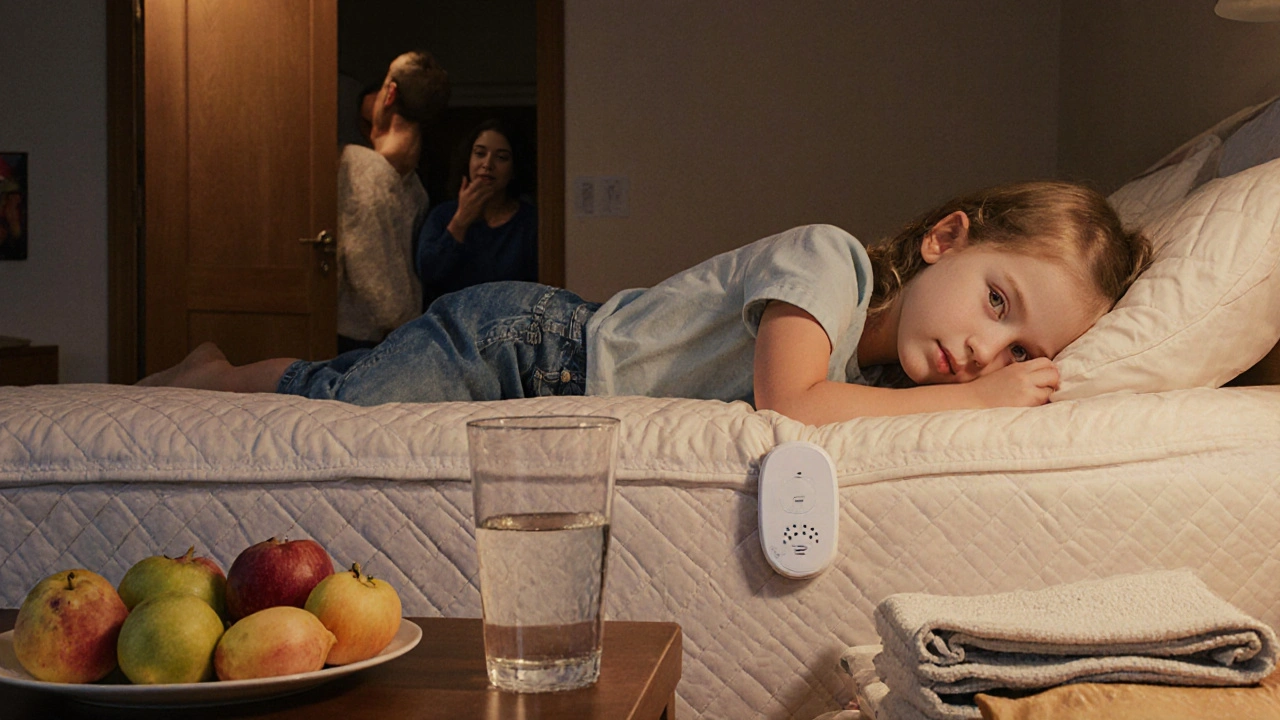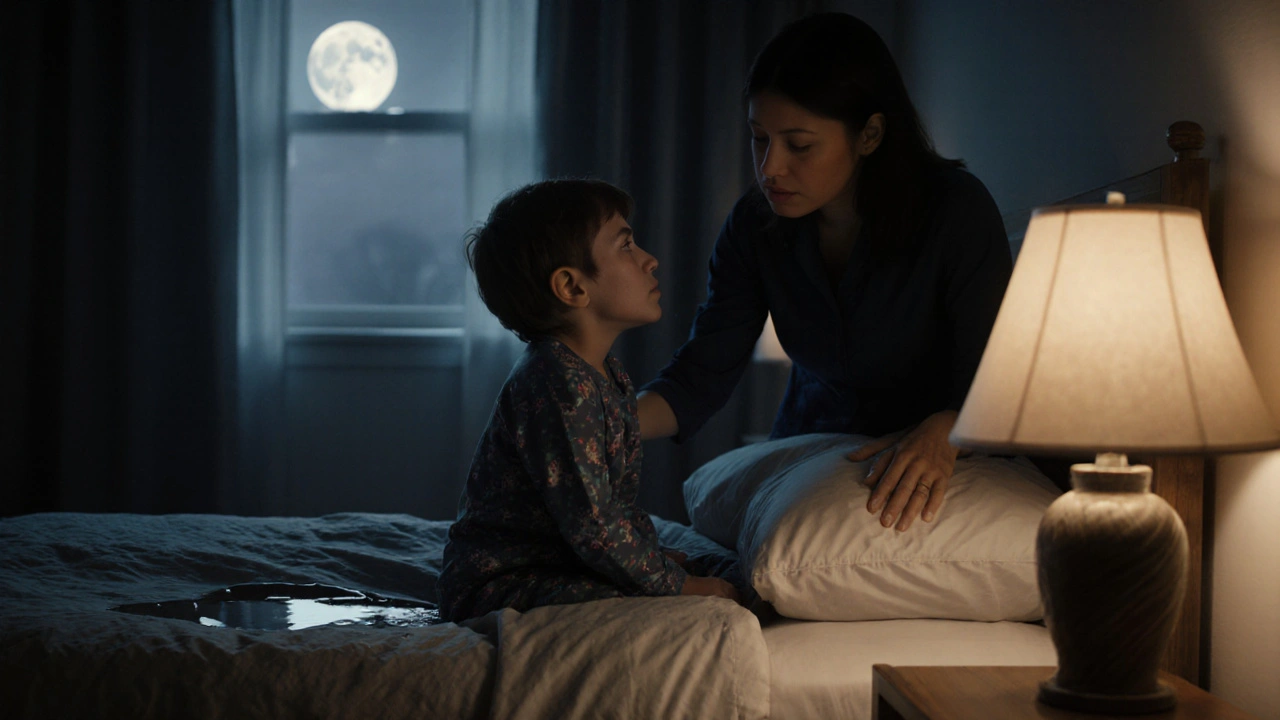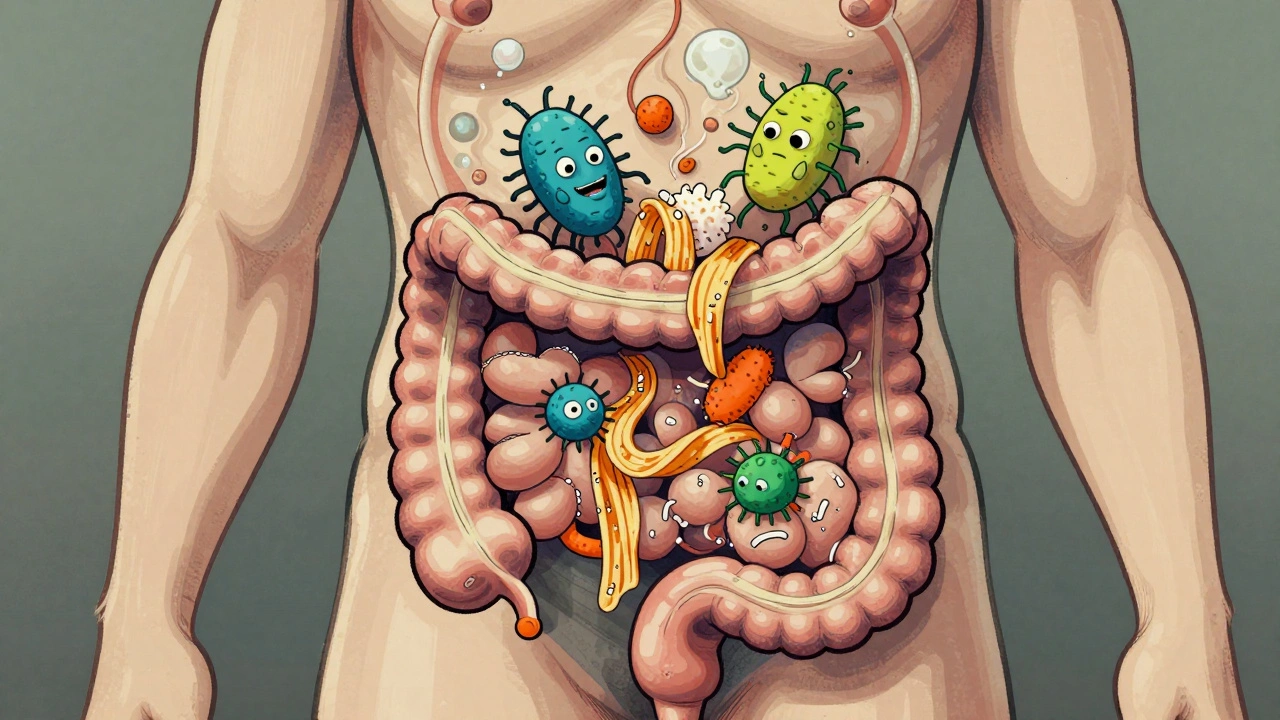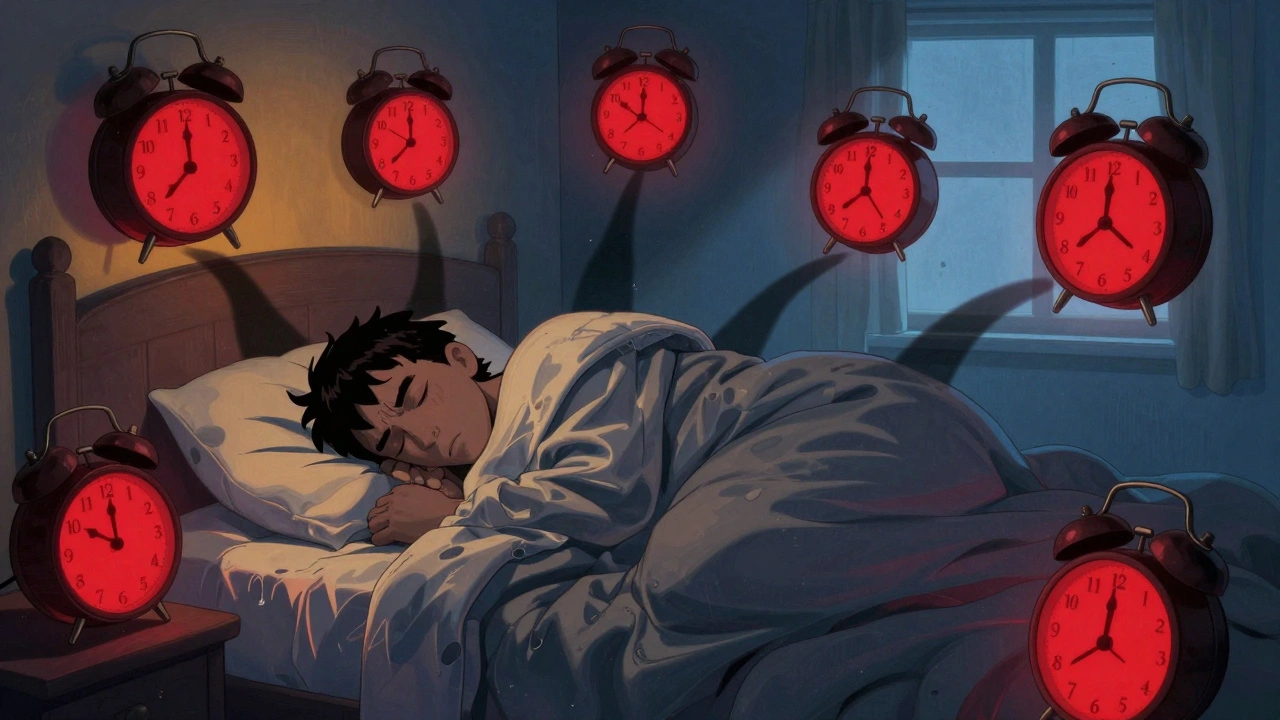Bed-Wetting Fluid Intake Calculator
Calculate Your Child's Fluid Needs
This tool helps you determine the right amount of fluids for your child to reduce bed-wetting.
Recommended Fluid Timing
How to space fluids throughout the day to help prevent bed-wetting.
Did you know that about 20% of five‑year‑olds still experience bed-wetting at night? It’s a common worry that many families face, yet the reasons and remedies are often misunderstood. This guide breaks down what’s really happening when the sheets stay wet, how to spot the underlying triggers, and what you can do right now to help.
Key Takeaways
- Bed-wetting, medically called nocturnal enuresis, affects up to 1 in 5 children and can persist into adulthood.
- Typical causes include low antidiuretic hormone levels, small bladder capacity, sleep‑related factors, and underlying health conditions such as urinary tract infections or diabetes.
- Effective treatments range from simple lifestyle tweaks to proven medical options like desmopressin or enuresis alarms.
- Prevention works best when you combine fluid management, bladder training, and a supportive bedtime routine.
- Seek professional evaluation if the problem lasts beyond 7years, appears suddenly, or is linked with pain, fever, or daytime urinary issues.
Understanding Bed‑wetting
When we talk about Bed-wetting is the involuntary release of urine during sleep, most commonly seen in children but also occurring in some adults, we’re referring to a condition that’s officially named Nocturnal Enuresis is the medical term for repeated nighttime urination beyond the age at which bladder control is expected. While a few kids outgrow it on their own, others need a bit of help to train their bodies and brains.
Common Causes
There’s no single culprit; most cases involve a mix of physiological, genetic, and environmental factors.
- Hormonal imbalance: The body’s antidiuretic hormone (ADH) normally reduces urine production at night. In some kids, ADH peaks later than usual, leading to a larger nighttime bladder load. Antidiuretic hormone is a hormone that signals the kidneys to retain water, decreasing urine output during sleep.
- Bladder capacity: A small bladder can fill quickly, overwhelming the sleep‑triggered urge‑to‑wake mechanism.
- Genetics: If a parent struggled with bed‑wetting, the child’s risk roughly doubles.
- Medical conditions: Infections or chronic illnesses can be the hidden trigger. For example, a Urinary Tract Infection is an infection that can irritate the bladder and cause urgency, including nighttime episodes may lead to sudden wetting. Diabetes mellitus is a metabolic disease that raises blood sugar and, consequently, urine output, often resulting in nocturnal enuresis is another red flag.
- Sleep‑related disorders: Conditions like obstructive Sleep apnea is a breathing interruption during sleep that can fragment deep sleep stages, reducing the brain’s ability to sense a full bladder can prevent the child from waking up when the bladder signals.
- Psychological stress: Major life changes-starting school, moving homes, or family tension-can manifest as nighttime wetting, even when physical causes are low.

How Doctors Diagnose the Issue
A pediatrician or family doctor will start with a thorough history: age of onset, frequency, daytime symptoms, and any recent health changes. They’ll often recommend a urine dip‑test to rule out infection, a blood glucose check if diabetes is suspected, and sometimes a bladder ultrasound to assess size and residual volume. In complex cases, a referral to a pediatric urologist may be needed for further studies such as urodynamics.
Treatment Options: What Works Best?
Choosing the right approach depends on the child’s age, the severity of episodes, and any underlying medical condition. Below is a quick comparison of the most common therapies.
| Option | Effectiveness | Onset of Results | Side Effects | Typical Cost (AU$) | Best For |
|---|---|---|---|---|---|
| Behavioral Therapy (bladder training, fluid scheduling) | 60‑70% | 4‑12 weeks | None | Low | Mild cases, motivated families |
| Enuresis alarm is a device that sounds when moisture is detected, conditioning the brain to wake up | 80‑90% | 2‑8 weeks | Discomfort wearing the device | Medium | Children ≥5years, consistent users |
| Desmopressin is a synthetic ADH analogue that reduces nighttime urine production | 70‑85% | 1‑2 days | Rare hyponatremia, headache | Medium‑high (prescription) | Severe cases, when alarms fail |
| Medications for constipation or bladder overactivity (e.g., oxybutynin) | 50‑65% | 1‑2 weeks | Dry mouth, constipation | Medium | Kids with documented bladder dysfunction |
Most experts start with the least invasive option. A structured bedtime routine, limiting fluids after dinner, and a simple bladder‑strengthening schedule can work wonders for many families. If those steps don’t cut it, an enuresis alarm is the next logical step because it teaches the brain to associate a full bladder with waking up. Medication like desmopressin is usually reserved for stubborn cases or when rapid control is needed-say, for a sleepaway camp.
Prevention Strategies to Try at Home
Even before you decide on a formal treatment, there are daily habits that can reduce night‑time accidents.
- Fluid timing: Encourage regular drinks during the day but taper off after 6p.m. Aim for a total daily intake of about 1.5L for a typical school‑age child.
- Bathroom before bed: Make a routine of using the toilet right before lights out, even if the child isn’t “feeling” the need.
- Limit bladder irritants: Reduce caffeine (found in chocolate and tea) and avoid carbonated drinks in the evening.
- Promote regular bowel movements: Constipation can press against the bladder, increasing leakage risk. A diet rich in fiber and adequate hydration helps.
- Use waterproof mattress protectors: This isn’t a treatment, but it eases cleanup and reduces stress for the child.

When to Call a Professional
If any of the following signs appear, it’s time to schedule a doctor’s visit:
- Bed‑wetting persists past age 7 without improvement.
- New onset after a period of dryness.
- Daytime urinary symptoms such as urgency, pain, or frequency.
- Accompanying fever, back pain, or unexplained weight loss (possible infection or diabetes).
- Family history of kidney disease or known sleep apnea.
Early evaluation can uncover treatable medical issues and prevent long‑term emotional impacts like low self‑esteem.
Putting It All Together: A Sample Action Plan
- Record wet‑night frequency for two weeks to establish a baseline.
- Implement fluid‑timing rules and a bathroom‑before‑bed habit.
- Introduce a high‑fiber diet and encourage regular exercise to avoid constipation.
- If episodes remain >3times/week, start an enuresis alarm and track nightly progress.
- After four weeks, re‑evaluate. If success is <70%, discuss desmopressin with your pediatrician.
Consistency is key-most families see noticeable improvement within a month of sticking to the plan.
Frequently Asked Questions
Is bed‑wetting ever a sign of something serious?
While most cases are benign, persistent wetting after age7, sudden onset, or accompanying symptoms like pain, fever, or excessive thirst can indicate infections, diabetes, or sleep disorders that need medical attention.
Can adults outgrow bed‑wetting?
Yes, many adults who develop nocturnal enuresis due to stress or a temporary condition find relief once the trigger resolves, but chronic adult cases should be evaluated for underlying health issues.
How long does an enuresis alarm take to work?
Most children show a reduction in wet nights within 2‑8weeks, provided the alarm is used every night and the child isn’t removed from the routine.
Are there any risks with desmopressin?
Desmopressin is generally safe, but rare cases of low sodium levels (hyponatremia) can occur, especially if fluid intake isn’t limited. Always follow a doctor’s dosing instructions.
Should I punish my child for wetting the bed?
Punishment is counter‑productive. Bed‑wetting is involuntary, and shaming can increase stress, which may worsen the problem. Positive reinforcement and consistent routines are far more effective.







Nancy Lee Bush
October 12, 2025 AT 04:08Wow!!! This guide is super helpful!!! 🌟 Consistency is key-keep tracking fluids and celebrate even the tiniest victories! 😊
Dan Worona
October 21, 2025 AT 18:49There’s a hidden agenda behind the seemingly innocent fluid‑timing charts presented here.
Big pharmaceutical companies have long pushed the narrative that simple behavioral tweaks will solve nocturnal enuresis, because they want to keep the lucrative market for prescription desmopressin alive.
Think about it: the moment you start limiting fluids after 6 p.m., the sales of over‑the‑counter electrolyte drinks spike as parents scramble for alternatives.
The data in this article conveniently omits any mention of how drug companies fund many of the clinical trials that endorse desmopressin as a first‑line therapy.
Moreover, the alarm devices sold by tech giants are often bundled with subscription services that track your child’s sleep patterns and sell that data to advertisers.
It’s no coincidence that the same corporations own the patents on the moisture sensors used in those en‑uresis alarms.
While the article advises a "balanced approach", the underlying economics favor a cycle of product dependence.
I’ve seen internal memos leaked that discuss how to market bedtime routines as a way to upsell premium accessories.
The recommendation to avoid caffeine after 6 p.m. is useful, but it also pushes parents toward specialty herbal teas that are marketed as 'sleep‑enhancing' and carry a hefty price tag.
Don’t be fooled by the veneer of scientific neutrality; every paragraph is carefully curated to keep you buying more.
In fact, some pediatric urologists are paid consultants for alarm manufacturers, which explains why they rave about 80‑90 % effectiveness without mentioning the compliance burden.
The subtle language-'suggest', 'consider', 'may help'-is classic soft‑sell copywriting that masks a profit‑driven motive.
If you look at the funding disclosures of the studies cited, you’ll notice a pattern of corporate sponsorship.
So before you follow the fluid‑cut‑off at 6 p.m., ask yourself who benefits from your compliance.
The truth is, the battle for your child’s dry nights is being waged in boardrooms, not just in pediatric clinics.
Mita Son
October 31, 2025 AT 09:29Alright, listen up-this isn’t rocket science, but it’s definitely not as simple as 'just drink less after dinner'! The hormonal imbalance thing? Totally real, and if you ignore it, you’re basically telling your kid to suffer. I’ve read dozens of studies, so trust me, the bladder‑capacity myth is just a lazy excuse parents throw around. And yeah, genetics play a part-if ur mom or dad wet the bed, guess what? The kid probably will too, no surprise there. Stop blaming the child; the real problem is a combination of bad habits, hidden UTIs, and that sneaky sugar in bedtime snacks. Also, there’s a lot of misinformation out there-people say ‘just use an alarm’, but if the alarm’s broken, you’re back to square one. So get a proper checkup, limit those sugary drinks, and maybe try a desmopressin if nothing else works. It’s not magic, but it works-definately give it a shot before you give up!.
ariel javier
November 10, 2025 AT 00:10Frankly, the article glosses over the most critical factor: accountability. Parents who perpetuate a permissive environment are enabling chronic enuresis, and the so‑called “supportive routines” only mask their negligence. The recommendations are vague, the data is superficial, and the tone is overly sympathetic to an issue that demands disciplined intervention. Ignoring sleep‑apnea as a potential cause is an egregious oversight, as are the scant references to behavioral conditioning. A more rigorous, evidence‑based protocol should be mandated, not this half‑hearted checklist.
Bryan L
November 19, 2025 AT 14:51Hey there! 🌈 I totally get how stressful night‑time accidents can be for the whole family. The fluid‑timing guide is a great start, and pairing it with a calming bedtime routine can make a huge difference. Remember to celebrate every dry night, no matter how small-those wins build confidence! If you ever need extra tips or just a listening ear, I’m here. 💪
joseph rozwood
November 29, 2025 AT 05:31Well, this article attempts to appear comprehensive, yet it falls into the classic trap of shallow optimism. The fluid‑calculator is a gimmick, an oversimplification that ignores the nuanced physiology of ADH secretion. One would expect a deeper dive into urodynamic studies rather than a bullet‑point list that reads like a kindergarten handout. Moreover, the cost analysis is vague-what does ‘medium‑high’ really entail? In short, the piece offers a veneer of helpfulness while skimping on substantive evidence. It’s disappointingly mediocre.
Richard Walker
December 8, 2025 AT 20:12I think the guide does a solid job of covering both medical and practical aspects without overly pushing any single solution. The fluid‑timing recommendations are sensible, and the emphasis on a supportive environment is key. It’s also good that they advise seeing a doctor if red‑flag symptoms appear. Overall, a balanced resource for parents navigating this tricky issue.